TLS in Kubernetes
TLS in Kubernetes
To secure a Kubernetes cluster, we need to encrypt:
- Communication between master and worker nodes.
- Communication between clients (users) and the cluster.
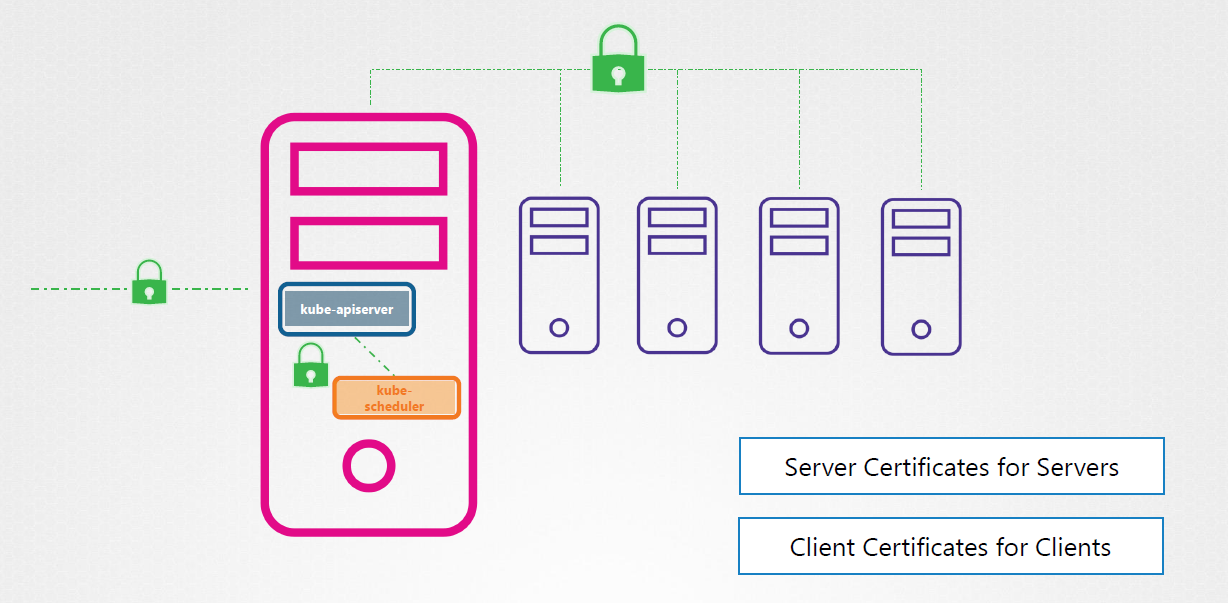
There are three types of certificates we need:
- Root certificates (CA)
- Server certificates
- Client certificates
Server Certificates for Servers
In self-managed Kubernetes clusters (e.g., using kubeadm), you need to generate the following keypairs:
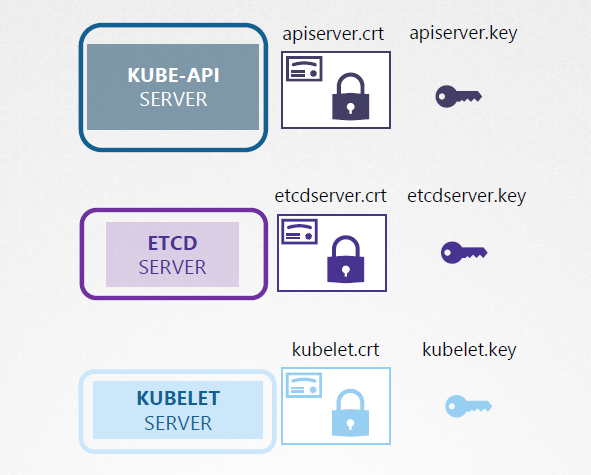
Client Certificates
For the client's side, there's actually four clients that talks to the kube-apiserver.
- admin/users
- kube scheduler
- kube-controller manager
- kube-proxy
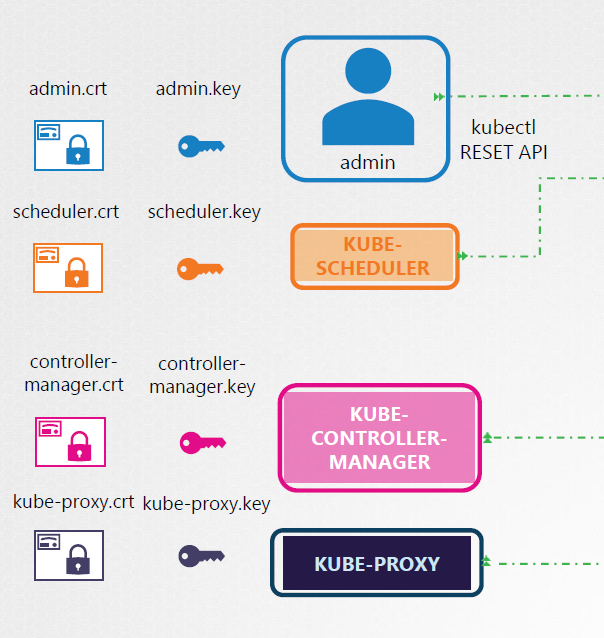
Root Server (CA)
In a Kubernetes setup, the CA is simply a pair of key and certificate files. The server where these files are securely stored are called the CA server. These certificates can also be placed in the master node, which makes the master node a CA server.
Generating the Certificates
You can use these tools to generate certificates:
- EasyRSA
- OpenSSL
- CFSSL
Certificate Authority (CA) Certificates
-
Generate a private key for the CA:
openssl genrsa -out ca.key 2048 -
Generate a CSR (Certificate Signing Request) with the private key:
openssl req -new -key ca.key -subj "/CN=KUBERNETES-CA" -out ca.csr -
Sign the CSR to create the CA certificate:
openssl x509 -req -in ca.csr -signkey ca.key -out ca.crt
This CA key pair is used to sign all other certificates.
Client Certificates
-
Generate a private key for the client:
openssl genrsa -out admin.key 2048 -
Create a CSR for the client:
openssl req -new -key admin.key -subj "/CN=kube-admin/O=system:master" -out admin.csr -
Sign the client certificate:
openssl x509 -req -in admin.csr -CA ca.crt -CAkey ca.key -out admin.crt
Other Client Certificates
The same steps is followed for generating the other client certificates:
- Generate a private key.
- Create a CSR.
- Sign the certificate.
The other server certificates need to be generated (for self-managed Kubernetes cluster):
- kube scheduler
- kube-controller manager
- kube-proxy
Server Certificates
The same steps is followed for generating the other client certificates:
- Generate a private key.
- Create a CSR.
- Sign the certificate.
The following set of certs need to be generated:
- etcd server certificate
- kube-api server certificate
- kubelet certificate
For the etcd server, it can be deployed in an HA setup thus we will need additional peer certificates. The certificates are then specified in the etcd.yaml file alogn with the CA root certificate.
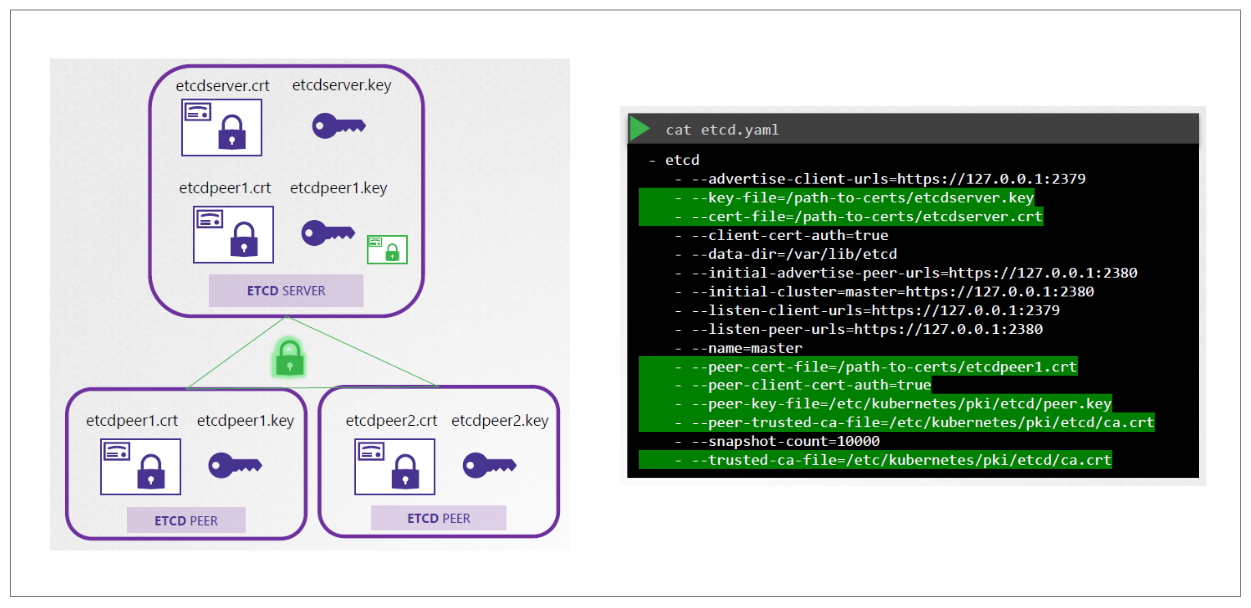
For the kube-apiserver, we can specify an openssl.cnf file and specify the alternate names for the kube-apiserver.
[ req ]
req_extensions = v3_req
[v3_req]
basicConstraints = CA:FALSE
keyUsage = nonRepudiation ,
sibjectAltName = @alt_names
[alt_names]
DNS.1 = kubernetes
DNS.2 = kubernetes.default
DNS.3 = kubernetes.default.svc
DNS.4 = kubernetes.default.svc.cluster.local
IP.1 = 10.23.45.61
IP.2 = 172.16.1.88
Generate the private key the same way:
openssl genrsa -out apiserver.key 2048 # apiserver.key
Create the CSR. Make sure to specify the config file.
openssl req -new -key admin.key -subj \
"/CN=kube-apiserver" -out apiserver.csr \
-config openssl.cnf
Then sign the certificate:
openssl x509 -req -in apiserver.csr \
-CA ca.crt -CAkey ca.key -out apiserver.crt
The location of these certificates are also passed to the kube-apiserver service.
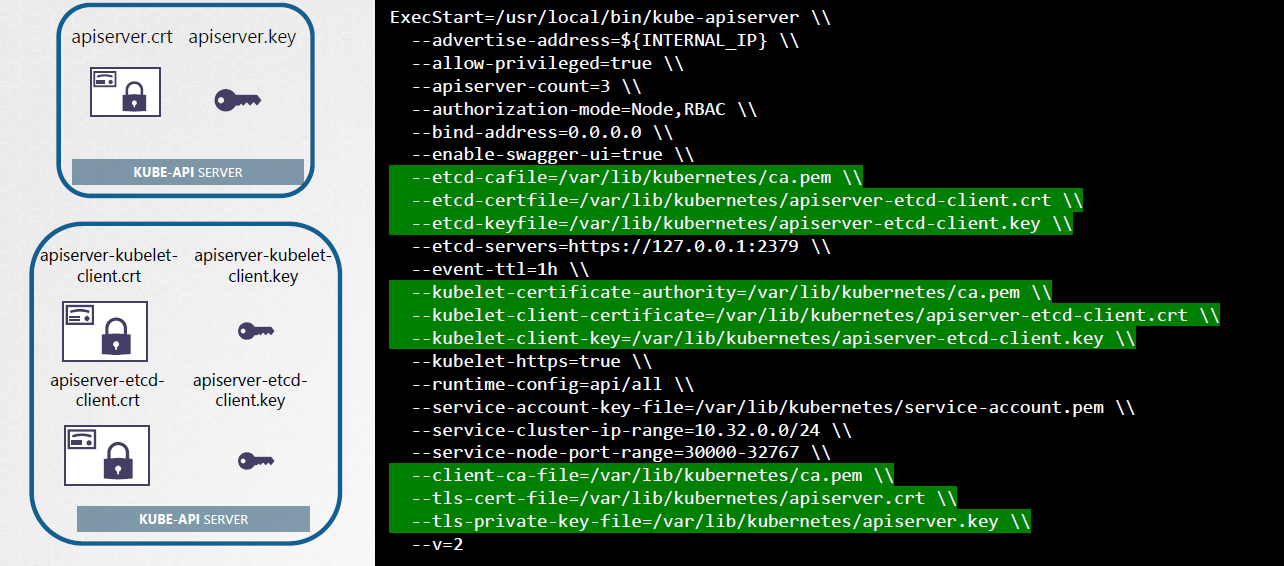
Alternatively, specify certificate paths in the kube-apiserver command line.
kube apiserver \
--client-ca-file=/etc/kubernetes/pki/ca.crt \
--etcd-cafile=/etc/kubernetes/pki/etcd/ca.crt \
--etcd-certfile=/etc/kubernetes/pki/apiserver-etcd-client.crt \
--etcd-keyfile=/etc/kubernetes/pki/apiserver-etcd-client.key \
--tls-cert-file=/etc/kubernetes/pki/apiserver.crt \
--tls-private-key-file=/etc/kubernetes/pki/apiserver.key
Using the Certificates
To use certificates in API calls:
curl https://kube-apiserver:6443/api/v1/pods/
--key admin.key \
--cert admin.crt \
--cacert ca.crt
They can also be specified in a kube-config.yaml file.
apiVersion: v1
kind: Config
clusters:
- name: kubernetes
cluster:
certificate-authority: ca.crt
server: https://kube-apiserver:6443
users:
- name: kubernetes-admin
user:
client-certificate: admin.crt
client-key: admin.key
View Certificate Details
For a Kubernetes Cluster that is setup via kubeadm, look for the YAMl file for kube-apiserver.
cat /etc/kubernetes/manifests/kube-apiserver.yaml
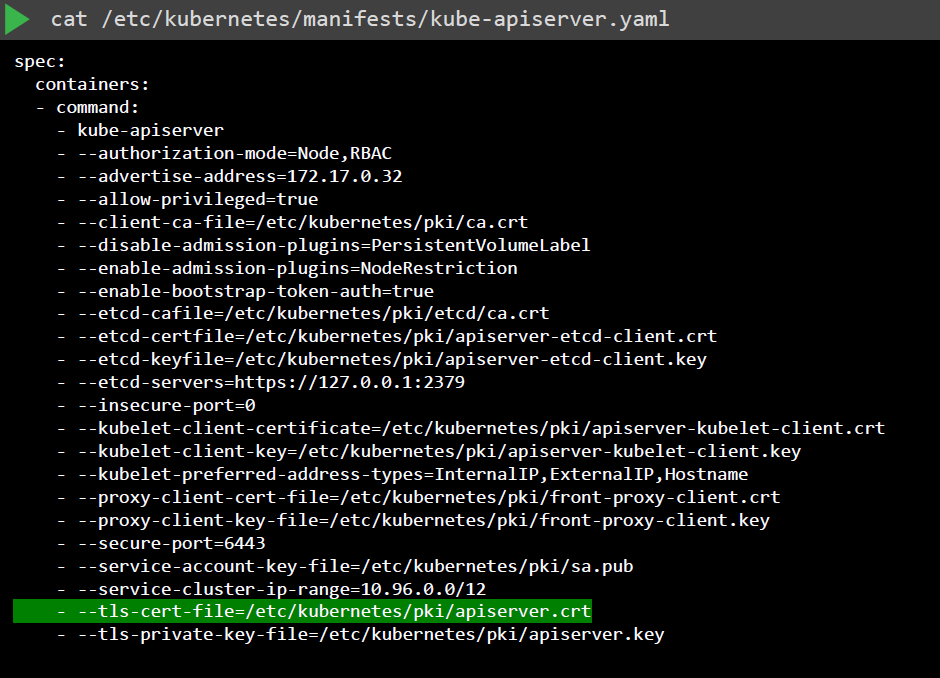
Then, use OpenSSL to inspect individual certificates:
openssl x509 -in /etc/kubernetes/pki/apiserver.crt -text -noout
Check the following:
- Issuer of the certificate (CA)
- "Not after" to check if certificate is still valid
- Subject section
- Alternative names
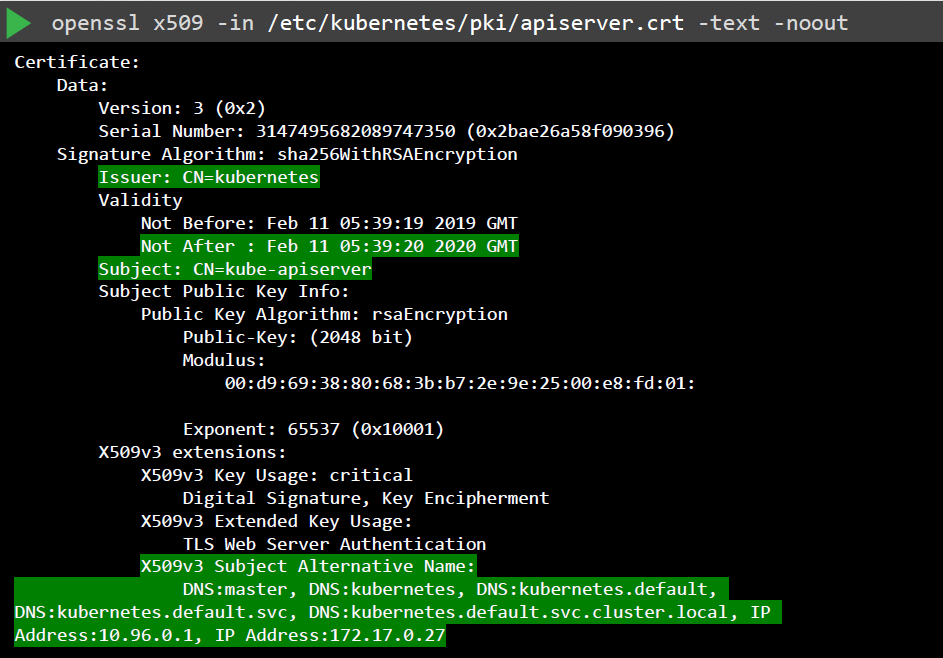
Perform the same checks on the other certificates.
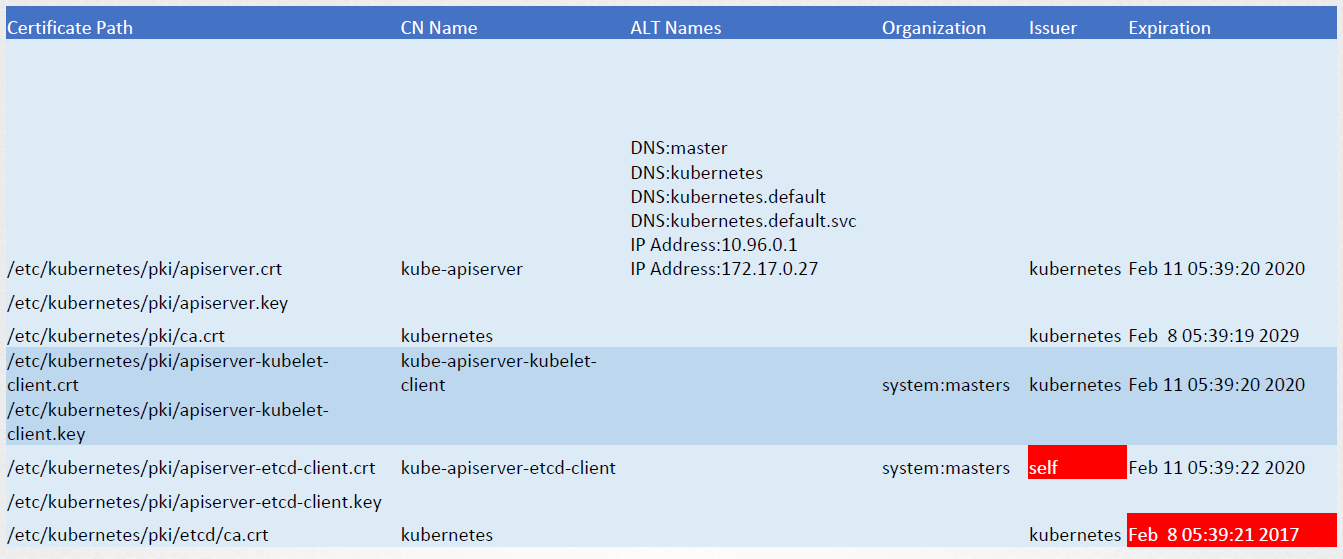
Certificates API
Kubernetes provides a certificates API to manage certificate signing and rotation.
-
User creates a private key:
openssl genrsa -out jane.key 2048 -
Create a CSR:
openssl req -new -key jane.key -subj "/CN=jane" -out jane.csr -
Admin creates a CSR object via YAML:
apiVersion: certificates.k8s.io/v1
kind: CertificateSigningRequest
metadata:
name: jane
spec:
groups:
- system:authenticated
usages:
- digital signature
- key encipherment
- server auth
request: <base64_encoded_csr> -
The CSR can be reviewed and approved using
kubectl:kubectl get csr
kubectl certificate approve jane -
The approved certificate can be retrieved and shared:
kubectl get csr jane -o yaml
cat jane-approved.csr | base64 --decode
Controller-Manager handles all
The Controller Manager manages certificate operations in the cluster.

To sign the certificates, recall that we need the CA root server and private key. These files are also defined in the Controller Manager's definitions file.

Inspect Logs
As additional troubleshooting steps, we can check the logs for any certificate-related issues.

For kubeadm-managed cluster:
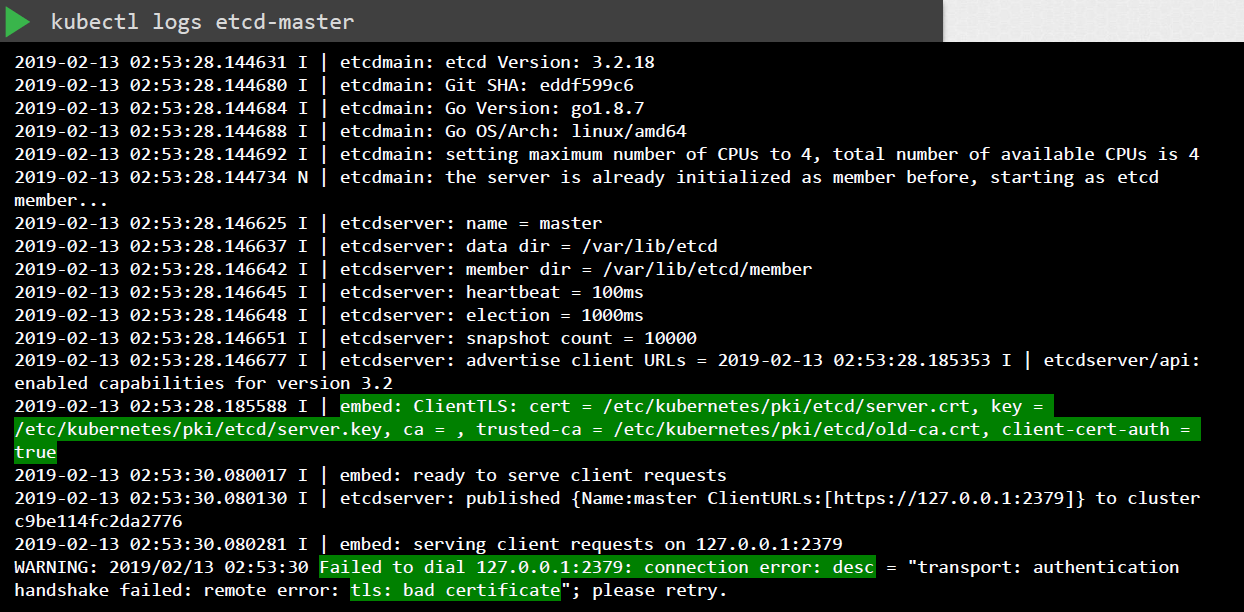
If kubectl is down, use Docker CLI to inspect logs:
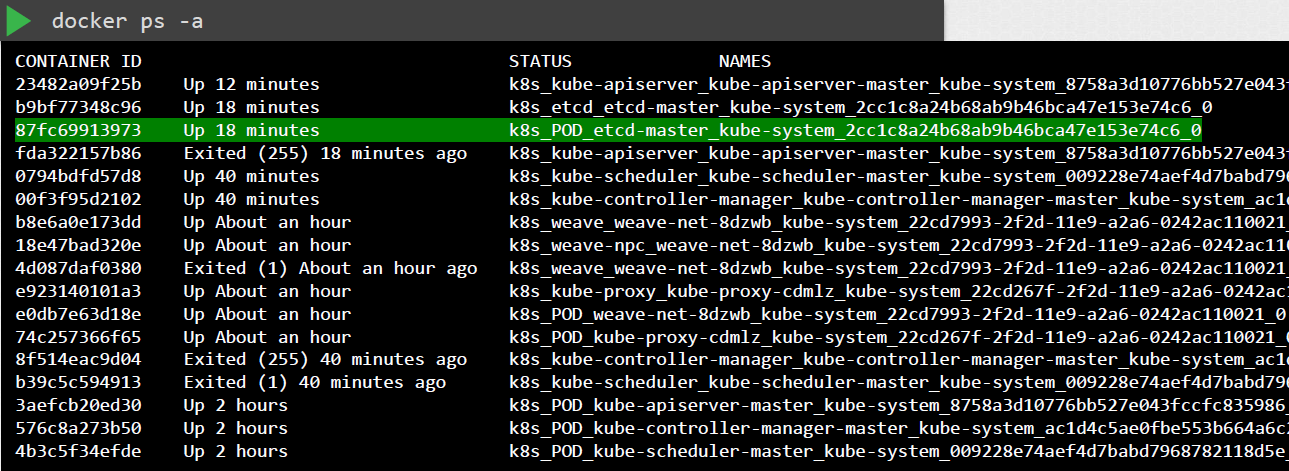
![]()